eBook Writer – Write Better eBooks Faster Than Ever [Start for Free]
Use an AI eBook Writer and Write Better eBooks Faster than ever before. Use the AI eBook Generator for full chapters, titles, outlines, and more.
Let’s get started and see how you can use the AI eBook Writer.
Chapters
What is an AI eBook Writer?
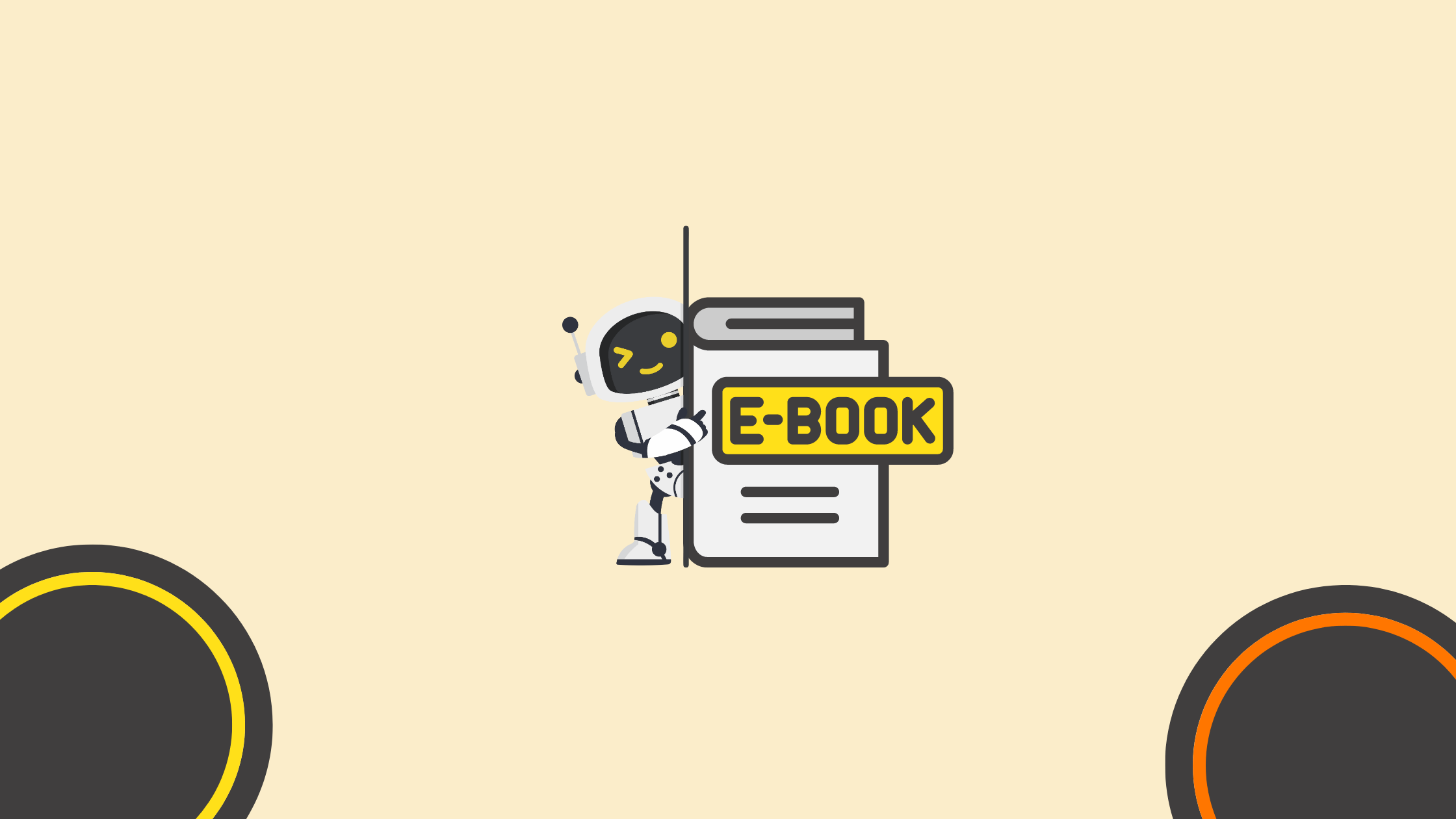
An AI eBook Writer is a software application or tool powered by artificial intelligence that assists in the creation of eBooks. These tools use natural language processing (NLP) and machine learning algorithms to generate text, structure content, and provide creative suggestions. The AI can generate written content based on prompts or themes provided by the user, including drafting ideas, titles, outlines, and chapters on specified topics.
Some AI tools assist with brainstorming ideas, plot points, and character development for fiction writing, or outlining and structuring content for non-fiction. Advanced AI eBook Writers can customize the writing style, tone, and voice to match their preferences or the target audience’s expectations.
Let’s see how StoryLab.ai’s AI eBook Writer works.
Using an AI eBook Writer to Come up with eBook Ideas
Creating an eBook is a significant investment of time and effort, and jumping into the first idea that comes to mind isn’t the best strategy. With StoryLab.ai’s eBook Idea Generator, you can explore a variety of compelling concepts before committing to the one that truly stands out.
This powerful eBook Writing Tool helps you brainstorm innovative eBook ideas from multiple angles, ensuring you never get stuck in the creative process. By using our AI eBook Idea Writer, you can gain fresh perspectives on your main idea, refine your concept, and set the stage for a truly impactful eBook.
Let StoryLab.ai ignite your creativity and guide you toward the perfect eBook Idea.
Here are the inputs we’ve used for the eBook Idea Writer:
- Tone of voice: Witty
- Style: Storytelling
- Content goals: Storytelling
- Target audience: Marketers
- Topic: How to Write an eBook
Here’s what the AI eBook Idea Writer came up with:
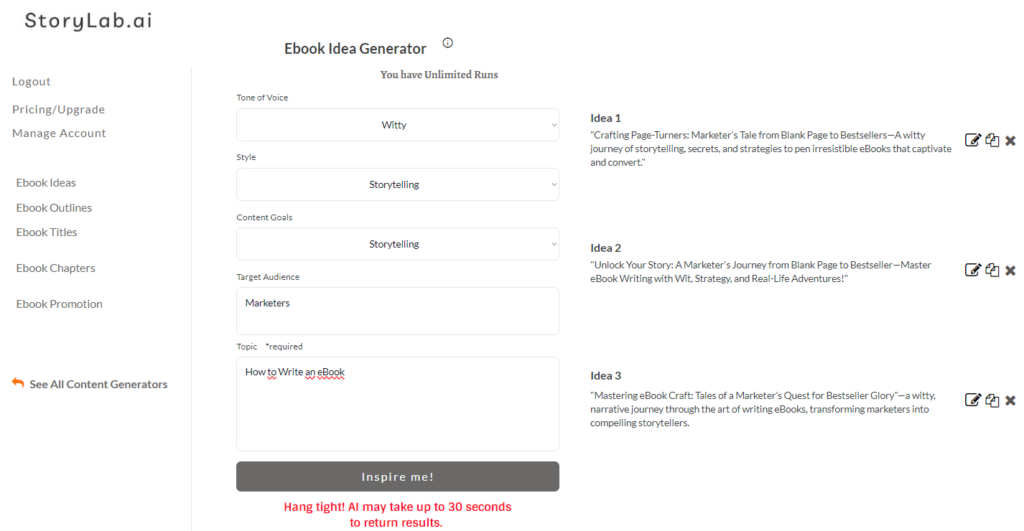
AI eBook Idea Writer Output Examples
Crafting Page-Turners: Marketer’s Tale from Blank Page to Bestsellers—A witty journey of storytelling, secrets, and strategies to pen irresistible eBooks that captivate and convert.
Unlock Your Story: A Marketer’s Journey from Blank Page to Bestseller—Master eBook Writing with Wit, Strategy, and Real-Life Adventures!
Mastering eBook Craft: Tales of a Marketer’s Quest for Bestseller Glory”—a witty, narrative journey through the art of writing eBooks, transforming marketers into compelling storytellers.
Here’s what the eBook Idea Writer came up with when we changed the tone to comedic and style to explainer:
From Procrastination to Publication: A Marketer’s Hilarious Guide to Writing Your First eBook – Complete with Epic Fails, Triumphs, and Plenty of Coffee Spills!
Write and Laugh: A Marketer’s Guide to Ebook-Mastery with Humor, Hacks, and Hilarity, turning the art of storytelling into your ultimate power tool for digital domination!
Write & Wreck-It: Marketers’ Hilarious Guide to Crafting an eBook That Sells Itself! From blank page to bestseller, with side-splitting tips and laugh-inducing anecdotes. Get ready to giggle and grow!
Using an AI eBook Writer to Come up with eBook Outlines
Now let’s have a look at the AI eBook Outline Writer.
Discover the power of our AI-driven eBook Outline Generator, designed to help you craft a perfect structure for your eBook effortlessly. With this innovative tool, you can quickly develop detailed chapters and subchapters, setting a solid foundation for your eBook. Once your outline is ready, seamlessly transition to our other AI tools to create captivating eBook chapters, engaging titles, and effective eBook promotional material.
Get started for free and experience how our AI eBook Outline Writer can accelerate your writing process, enabling you to produce high-quality eBooks faster than ever before. While our AI tools provide invaluable assistance, remember to infuse your unique human touch to make your eBook truly shine. Let AI be your inspiration on this creative journey.
Let StoryLab.ai ignite your creativity and guide you toward the perfect eBook outline.
Here are the inputs we’ve used for the eBook Outline Writer:
- Tone of voice: Witty
- Style: Explainer
- Content goals: Educate
- Target audience: Marketers
- Topic: How to Write an eBook
Here’s what the AI eBook Outline Writer came up with:
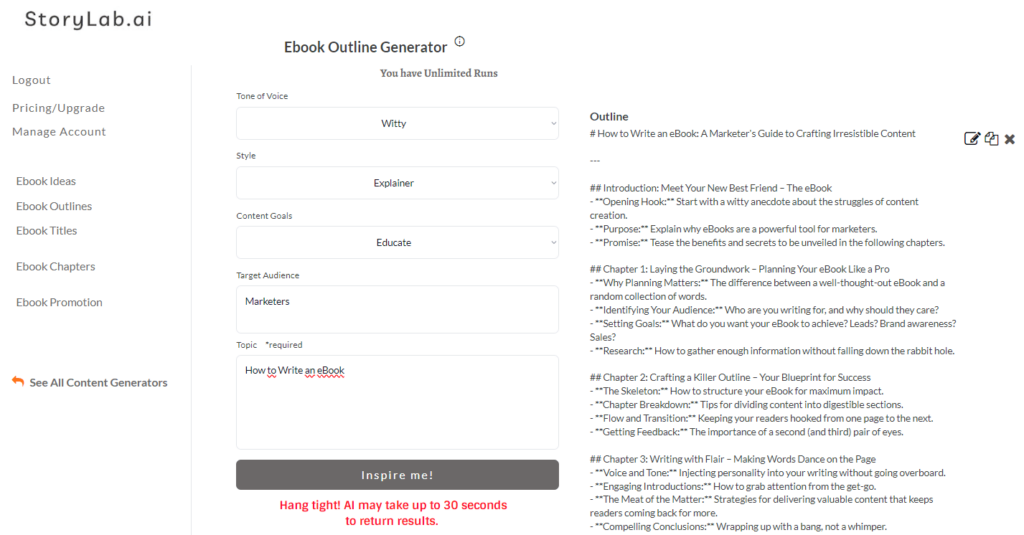
AI eBook Outline Writer Output Examples
Outline
How to Write an eBook: A Marketer’s Guide to Crafting Irresistible Content
Introduction: Meet Your New Best Friend – The eBook
– Opening Hook: Start with a witty anecdote about the struggles of content creation.
– Purpose: Explain why eBooks are a powerful tool for marketers.
– Promise: Tease the benefits and secrets to be unveiled in the following chapters.
Chapter 1: Laying the Groundwork – Planning Your eBook Like a Pro
– Why Planning Matters: The difference between a well-thought-out eBook and a random collection of words.
– Identifying Your Audience: Who are you writing for, and why should they care?
– Setting Goals: What do you want your eBook to achieve? Leads? Brand awareness? Sales?
– Research: How to gather enough information without falling down the rabbit hole.
Chapter 2: Crafting a Killer Outline – Your Blueprint for Success
– The Skeleton: How to structure your eBook for maximum impact.
– Chapter Breakdown: Tips for dividing content into digestible sections.
– Flow and Transition Keeping your readers hooked from one page to the next.
– Getting Feedback: The importance of a second (and third) pair of eyes.
Chapter 3: Writing with Flair – Making Words Dance on the Page
-Voice and Tone: Injecting personality into your writing without going overboard.
-Engaging Introductions: How to grab attention from the get-go.
-The Meat of the Matter: Strategies for delivering valuable content that keeps readers coming back for more.
-Compelling Conclusions: Wrapping up with a bang, not a whimper.
Chapter 4: The Visual Feast – Designing an eBook That Looks as Good as It Reads
-Cover Design: First impressions and why they matter.
-Layout and Formatting: Ensuring not just readability, but enjoyability.
-Visuals: Using images, infographics, and charts to enhance comprehension and retention.
-Tools and Resources: Design software and templates to make your life easier.
Chapter 5: Editing – The Art of Polishing Your Masterpiece
– Self-Editing Tips: Common pitfalls and how to avoid them.
– Professional Editing: When and why you should consider hiring an expert.
– Proofreading: Techniques to catch every last typo and error.
– Beta Readers: The unsung heroes of the editing process.
Chapter 6: The Perfect Launch – Getting Your eBook into the Hands of Readers
– Pre-Launch Hype: Building anticipation with teasers and sneak peeks.
– Distribution Channels: Where to publish your eBook for maximum reach.
– Pricing Strategies: How to set a price that reflects your value proposition.
– Promotional Tactics: Social media, email marketing, partnerships, and more.
Chapter 7: Measuring Success – Analyzing Your eBook’s Performance
– KPIs and Metrics: What to track and why it matters.
– Feedback Loops: Using reader feedback to improve future eBooks.
– Iterating and Updating: Keeping your eBook relevant and fresh.
– Case Studies: Real-world examples of successful eBook launches and lessons learned.
Chapter 8: Beyond the eBook – Leveraging Content for Ongoing Marketing Success
– Repurposing Content: Turning chapters into blog posts, podcasts, and webinars.
– Building a Content Ecosystem: How your eBook fits into your broader marketing strategy.
– Long-Term Engagement: Using your eBook to foster lasting relationships with your audience.
– The Next Steps: Encouraging readers to take action, whether it’s subscribing to your newsletter or purchasing a product.
Conclusion: Your eBook Writing Journey Awaits
– Recap: Summarize key takeaways.
– Inspiration: A motivational finale to empower marketers to start writing.
– Call to Action: Direct readers to additional resources, tools, and communities for further support.
Bonus Chapter: Troubleshooting Common eBook Challenges
– Writer’s Block: Tips and tricks to overcome it.
– Scope Creep: Keeping your project on track.
– Tech Hiccups: Solutions for common technical issues.
– Reader Apathy: Strategies to reignite interest and engagement.
Resources
– Templates: Links to helpful planning and writing templates.
– Tools: Recommended software for writing and design.
– Reading List: Further reading to deepen your knowledge on eBook creation.
Acknowledgments
– Shout-Outs: Thanking those who inspired and supported the creation of this guide.
– Collaborations: Mentioning any partners or contributors.
About the Author
– Bio: A witty and engaging biography that showcases your expertise and personality.
Using an AI eBook Writer for Writing eBook Chapters
Now let’s have a look at the AI eBook Chapter Writer.
Unlock the power of our eBook Chapter Generator, your ultimate tool for crafting complete eBook chapters with ease. This advanced AI tool helps you create engaging intros, comprehensive main content, and impactful conclusions based on your inputs, perspective, and writing style.
Just describe the essence of your eBook chapter, share your point of view and preferred writing style, and let our AI eBook Chapter Writer do the rest. You’ll be amazed by the high-quality content it produces. Then, add your unique human touch to perfect each chapter, completing your eBook faster than ever before. Start revolutionizing your writing process today!
Here are the inputs we’ve used for the eBook Chapter Writer:
- Tone of voice: Witty
- Style: Explainer
- Content goals: Educate
- Target audience: Marketers
- Point of view: AI can help with writing an eBook
- Topic: How to Write an eBook
Here’s what the AI eBook Chapter Writer came up with:
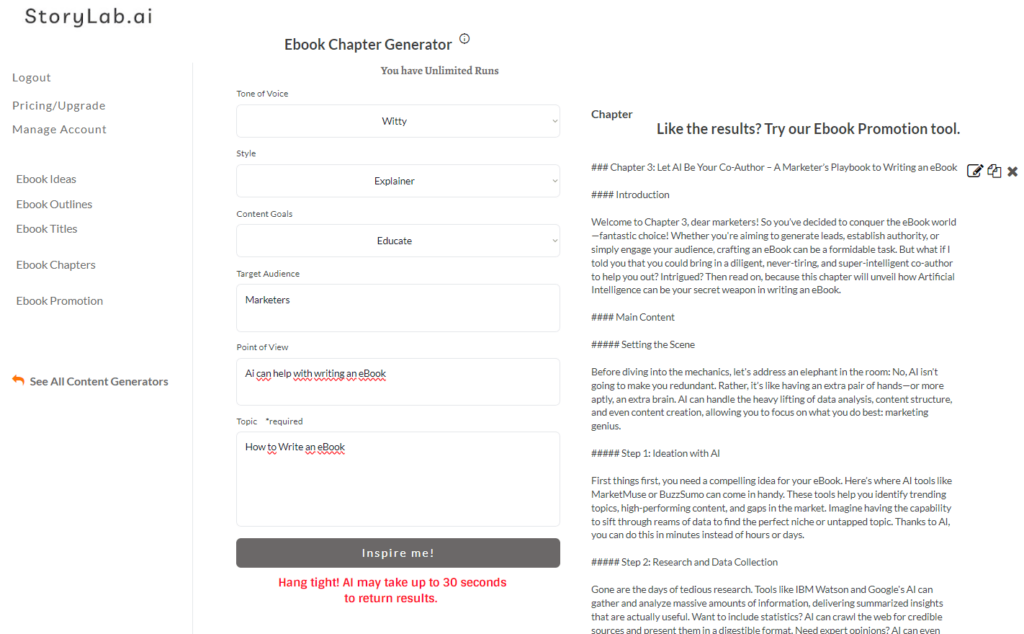
AI eBook Chapter Writer Output Examples
Chapter 3: Let AI Be Your Co-Author – A Marketer’s Playbook to Writing an eBook
Introduction
Welcome to Chapter 3, dear marketers! So you’ve decided to conquer the eBook world—fantastic choice! Whether you’re aiming to generate leads, establish authority, or simply engage your audience, crafting an eBook can be a formidable task. But what if I told you that you could bring in a diligent, never-tiring, and super-intelligent co-author to help you out? Intrigued? Then read on, because this chapter will unveil how Artificial Intelligence can be your secret weapon in writing an eBook.
Main Content
Setting the Scene
Before diving into the mechanics, let’s address an elephant in the room: No, AI isn’t going to make you redundant. Rather, it’s like having an extra pair of hands—or more aptly, an extra brain. AI can handle the heavy lifting of data analysis, content structure, and even content creation, allowing you to focus on what you do best: marketing genius.
Step 1: Ideation with AI
First things first, you need a compelling idea for your eBook. Here’s where AI tools like MarketMuse or BuzzSumo can come in handy. These tools help you identify trending topics, high-performing content, and gaps in the market. Imagine having the capability to sift through reams of data to find the perfect niche or untapped topic. Thanks to AI, you can do this in minutes instead of hours or days.
Step 2: Research and Data Collection
Gone are the days of tedious research. Tools like IBM Watson and Google’s AI can gather and analyze massive amounts of information, delivering summarized insights that are actually useful. Want to include statistics? AI can crawl the web for credible sources and present them in a digestible format. Need expert opinions? AI can even generate realistic interviews based on existing data. The bottom line: You get the facts and figures without suffering from information overload.
Step 3: Content Outline
Once you have your research, structuring your eBook is the next daunting task. AI-powered tools like Scrivener and Grammarly’s new outline feature can help you create a coherent and logical structure. These tools can suggest chapter headings, sub-sections, and even key points to cover, ensuring your eBook has a natural flow and keeps readers engaged.
Step 4: Writing the Content
Ah, the writing—the meat of the eBook. Tools like OpenAI’s GPT-4 can assist here. You can use it to draft initial paragraphs or even entire sections based on your outline and notes. Skeptical? Think of AI-generated text as your first draft. You can refine, tweak, and add your unique voice to make it resonate with your target audience. Consider it as having a diligent but verbose intern whose work you can always polish to perfection.
Step 5: Editing and Proofreading
Even Shakespeare had editors, and your eBook is no different. Grammarly, Hemingway, and ProWritingAid offer AI-driven editing solutions that can catch grammatical errors, improve readability, and ensure your tone is consistent. These tools can turn your draft into a polished, publication-ready masterpiece without you having to comb through every sentence meticulously.
Step 6: Design and Layout
Content is king, but let’s not ignore the throne it sits on. Tools like Canva and Adobe Spark use AI to help you design eye-catching covers and layout templates that are tailored to eBooks. These tools can even suggest color schemes and fonts that resonate with your target audience. A visually appealing eBook is more likely to keep your readers engaged and leave a lasting impression.
Step 7: Promotion and Distribution
Once your eBook is ready, the next step is to get it out there. AI tools like HubSpot and Mailchimp can help automate your promotional campaigns, analyze performance metrics, and even suggest improvements. Predictive analytics can pinpoint the best times to launch your eBook, the optimal price points, and the most effective marketing channels.
Conclusion
While the idea of writing an eBook might initially seem as big a challenge as climbing Everest without a Sherpa, introducing AI into your process can make it more akin to a leisurely hike with a helpful, knowledgeable guide. From ideation to promotion, AI can streamline tasks, provide insights, and even generate content, leaving you free to focus on strategy and creativity.
So marketers, don’t hesitate to let AI be your co-author. Embrace its capabilities, and you’ll find that writing an eBook doesn’t have to be a laborious chore; instead, it can be an enjoyable process that enhances your marketing prowess. Ready to get started? Go ahead and unleash the power of AI on your next eBook project. Trust me, your audience (and your workload) will thank you.
Best Practices Writing an eBook
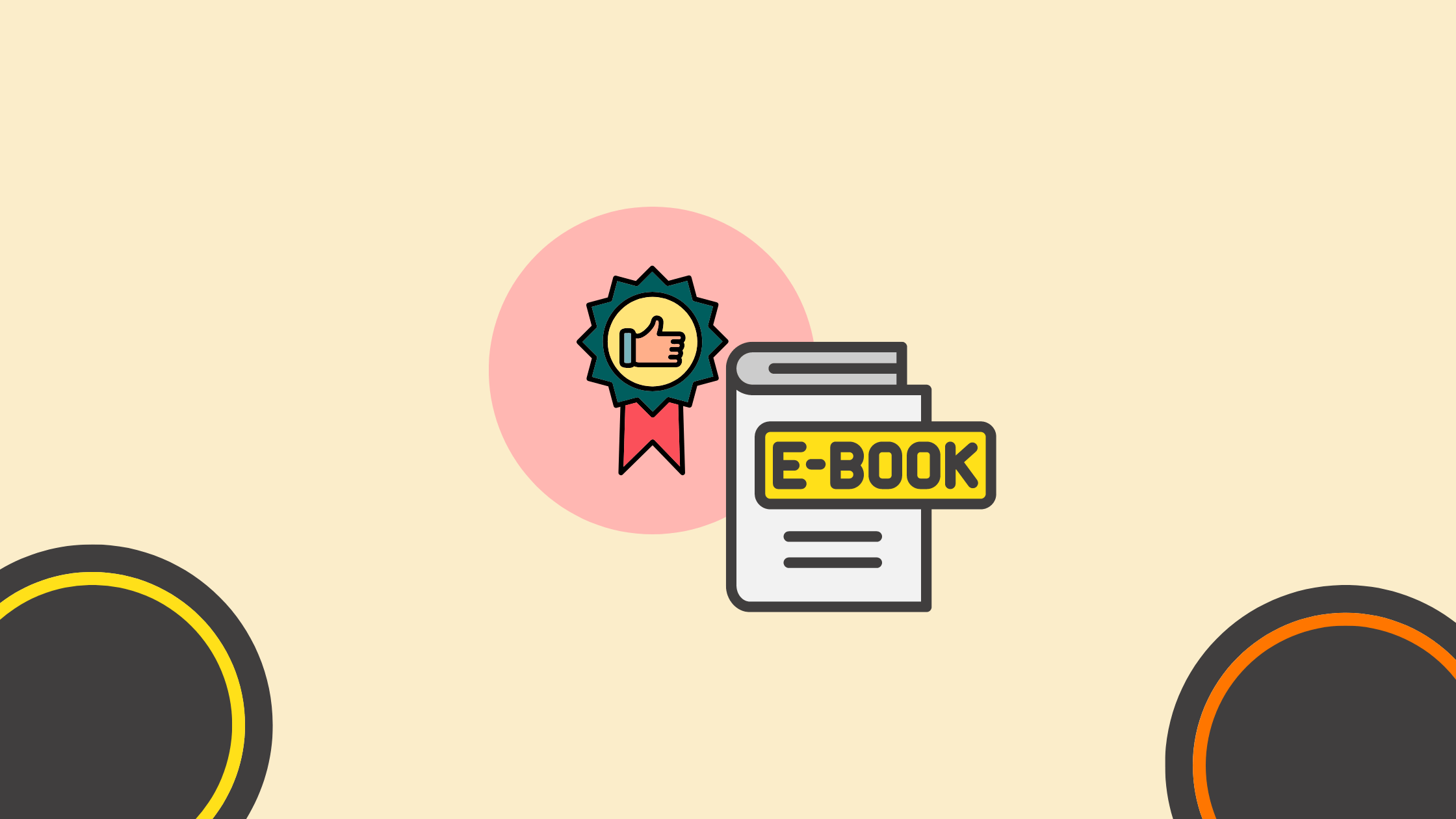
Writing an eBook can be a rewarding experience if approached with the right strategy. Here are some best practices to guide you through the process:
- Define Your Purpose and Audience: Start by clearly identifying the purpose of your eBook and who your target audience is. Understanding your audience’s needs and interests will help you create content that resonates with them.
- Choose a Compelling Topic: Select a topic that is both interesting to you and valuable to your readers. Conduct thorough research to ensure there is a demand for your chosen topic.
- Create an Outline: Develop a detailed outline to organize your thoughts and structure your eBook. Break down the content into chapters and sections to ensure a logical flow.
- Write an Engaging Introduction: The introduction sets the tone for your eBook. It should capture the reader’s attention and clearly state what they will gain from reading the book.
- Develop Quality Content: Focus on providing valuable, well-researched content. Write in a clear, concise, and engaging style. Use real-life examples, case studies, and data to support your points.
- Maintain a Consistent Tone and Style: Ensure your writing style and tone are consistent throughout the eBook. This helps in maintaining a cohesive reading experience.
- Incorporate Visuals: Use images, charts, infographics, and other visual elements to break up the text and enhance understanding. Visuals can also make your eBook more attractive and engaging.
- Edit and Proofread: Thoroughly edit and proofread your eBook to eliminate errors and improve readability. Consider hiring a professional editor for a polished final product.
- Format for Readability: Ensure your eBook is well-formatted for readability. Use headings, subheadings, bullet points, and spacing effectively. Choose an easy-to-read font and maintain consistent formatting.
- Add a Strong Conclusion and Call to Action: Summarize the key points in your conclusion and include a call to action. Encourage readers to apply what they’ve learned or to engage further with your content or services.
- Include Additional Resources: Provide links to additional resources, such as articles, videos, or other eBooks, to offer further value to your readers.
- Design an Attractive Cover: Your eBook cover is the first thing potential readers will see. Invest in a professional and eye-catching design that reflects the content of your book.
- Promote Your eBook: Plan a marketing strategy to promote your eBook. Use social media, email marketing, your website, and other channels to reach your target audience.
- Gather Feedback: After publishing, gather feedback from readers to understand what worked well and what could be improved. Use this feedback to enhance future editions or other eBooks.
By following these best practices, you can create a high-quality eBook that effectively communicates your message and provides value to your readers.
Master the Art of Video Marketing
AI-Powered Tools to Ideate, Optimize, and Amplify!
- Spark Creativity: Unleash the most effective video ideas, scripts, and engaging hooks with our AI Generators.
- Optimize Instantly: Elevate your YouTube presence by optimizing video Titles, Descriptions, and Tags in seconds.
- Amplify Your Reach: Effortlessly craft social media, email, and ad copy to maximize your video’s impact.